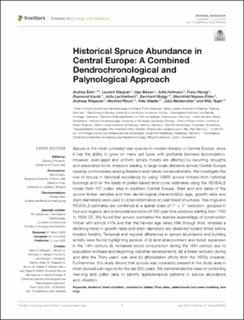| dc.contributor.author | Seim, Andrea | |
| dc.contributor.author | Marquer, Laurent | |
| dc.contributor.author | Bisson, Ugo | |
| dc.contributor.author | Hofmann, Jutta | |
| dc.contributor.author | Herzig, Franz | |
| dc.contributor.author | Kontic, Raymond | |
| dc.contributor.author | Lechterbeck, Jutta | |
| dc.contributor.author | Muigg, Bernhard | |
| dc.contributor.author | Neyses-Eiden, Mechthild | |
| dc.contributor.author | Rzepecki, Andreas | |
| dc.contributor.author | Rösch, Manfred | |
| dc.contributor.author | Walder, Felix | |
| dc.contributor.author | Weidemüller, Julia | |
| dc.contributor.author | Tegel, Willy | |
| dc.date.accessioned | 2023-03-21T11:32:29Z | |
| dc.date.available | 2023-03-21T11:32:29Z | |
| dc.date.created | 2022-08-22T09:32:52Z | |
| dc.date.issued | 2022 | |
| dc.identifier.citation | Seim, A., Marquer, L., Bisson, U., Hofmann, J., Herzig, F., Kontic, R., ... & Tegel, W. (2022). Historical spruce abundance in Central Europe: A combined dendrochronological and palynological approach. Front. Ecol. Evol, 10, 909453. | en_US |
| dc.identifier.issn | 2296-701X | |
| dc.identifier.uri | https://hdl.handle.net/11250/3059503 | |
| dc.description.abstract | Spruce is the most cultivated tree species in modern forestry in Central Europe, since it has the ability to grow on many soil types with profitable biomass accumulation. However, even-aged and uniform spruce forests are affected by recurring droughts and associated biotic stressors leading to large-scale diebacks across Central Europe causing controversies among foresters and nature conservationists. We investigate the role of spruce in historical woodlands by using 15666 spruce timbers from historical buildings and on the basis of pollen-based land cover estimates using the REVEALS model from 157 pollen sites in southern Central Europe. Start and end dates of the spruce timber samples and their dendrological characteristics (age, growth rates and stem diameters) were used to obtain information on past forest structures. Tree rings and REVEALS estimates are combined at a spatial scale of 1° × 1° resolution, grouped in four sub-regions, and a temporal resolution of 100-year time windows starting from 1150 to 1850 CE. We found that spruce dominates the species assemblage of construction timber with almost 41% and that the harvest age varies little through time, whereas a declining trend in growth rates and stem diameters are observed toward times before modern forestry. Temporal and regional differences in spruce abundance and building activity were found highlighting periods of (i) land abandonment and forest expansion in the 14th century, (ii) increased wood consumption during the 16th century due to population increase and beginning industrial developments, (iii) a forest recovery during and after the Thirty years' war, and (iv) afforestation efforts from the 1650s onwards. Furthermore, this study shows that spruce was constantly present in the study area in most studied sub-regions for the last 800 years. We demonstrate the need of combining tree-ring and pollen data to identify spatiotemporal patterns in spruce abundance and utilization. | en_US |
| dc.language.iso | eng | en_US |
| dc.publisher | Frontiers Media S.A. | en_US |
| dc.rights | Navngivelse 4.0 Internasjonal | * |
| dc.rights.uri | http://creativecommons.org/licenses/by/4.0/deed.no | * |
| dc.title | Historical Spruce Abundance in Central Europe: A Combined Dendrochronological and Palynological Approach | en_US |
| dc.type | Peer reviewed | en_US |
| dc.type | Journal article | en_US |
| dc.description.version | publishedVersion | en_US |
| dc.rights.holder | the authors | en_US |
| dc.subject.nsi | VDP::Matematikk og Naturvitenskap: 400::Basale biofag: 470 | en_US |
| dc.source.pagenumber | 0 | en_US |
| dc.source.volume | 10 | en_US |
| dc.source.journal | Frontiers in Ecology and Evolution | en_US |
| dc.identifier.doi | 10.3389/fevo.2022.909453 | |
| dc.identifier.cristin | 2044804 | |
| dc.source.articlenumber | 909453 | en_US |
| cristin.ispublished | true | |
| cristin.fulltext | original | |
| cristin.qualitycode | 1 | |

